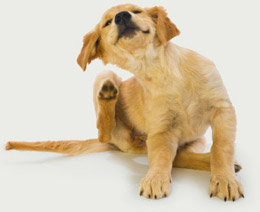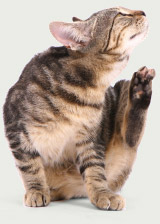
Natural flea control for cats, dogs and in the home.
Posted in Healthy Home & Pets on May 4, 2011. Last modified on April 25, 2019. Read disclaimer.
Seeing your cat or dog scratching itself may seem harmless at first. But if you notice your pet itching more frequently, it's possible that he or she (and you) have a flea problem! Depending on the specific type of fleas in your home, they can be more than just a nuisance. Various flea types can carry plague, tapeworms or rickettsiosis and lead to flea allergy dermatitis and anemia.
+ Free Shipping & Returns on Eligible Items.
How to detect fleas on your pet.
Fleas tend to favor areas around the thighs and the tail so check those areas first. Visible adult fleas, flea dirt (small dark, red dust-like flecks) or small pink bumps on the skin (which is a pet's allergic reaction to flea bites) are telltale signs. One way to check for flea dirt is to brush your pet's coat over a damp white paper. If the specks release a rusty red color, that's the sign of blood in flea feces.
The life cycle of a flea
(Duration can range from a few weeks to over a year, depending on temperature and humidity conditions.)
In order to get a handle on the problem, an effective flea control program must consider the four-stage life cycle of fleas.
While adult fleas live their life sucking blood on a host animal -- flea eggs, larvae and pupae (cocoon stage) are all found, not on your pet, but in dark, moist areas such as pet bedding, rugs, carpeting, along baseboards, and inside and under furniture where they feed on flea and pet feces, dead skin, feathers and other organic matter. In a comfortable home, they can thrive year-round.
Nine safe and effective ways to get rid of fleas and how to prevent fleas from reoccurring.
1. Brushing your pet with a flea comb: A flea comb not only captures fleas, it removes dead skin and flea feces that would otherwise flake off into bedding to feed flea larvae. As you remove fleas, drop them into hot soapy water, if possible, where they will drown.
2. Bathing pets in soapy water: Soap suds, left on the animal for 5-10 minutes is effective at drowning adult fleas and removing organic matter that can feed flea larvae. While there are medicated flea soaps on the market, some veterinarians recommend simple Dawn dishwashing liquid. Just be sure not to bath your pet too frequently which can dry their skin and worsen the problem.
3. Washing pet bedding in hot, soapy water: It is best to assign one area for your pets to sleep - and clean it regularly. Adult fleas drown easily in soapy water.

4. Vacuuming carpets, rugs, flooring cracks and crevices, under beds, couches and anywhere your pets have access to: This is one of the most important things you can do to get control of the flea problem. Weekly or even daily vacuuming helps reduce the number of fleas through all life stages as well as larvae food sources. In addition, the vacuum's vibration can trigger pupae stage fleas to emerge, making them vulnerable to any on-pet flea medication. The vacuum bag should immediately be removed, sealed in a plastic bag and trashed outside the home.
5. Steam cleaning furniture, carpeting and rugs: The hot steam and soap will get rid of the fleas of all life stages that were missed by vacuuming alone.
6. Controlling wild animals in, under and around your house: Opossum, raccoons, stray cats, chipmunks, rats, mice, and other rodents can host various types of disease-carrying fleas.
7. Setting out flea traps: By emitting light and warmth, flea traps attract fleas where they become trapped on non-toxic, sticky pads which can easily be disposed of.
8. Sprinkling diatomaceous earth: This non-toxic powder can be sprinkled very lightly to suspected flea "hot spots" like carpeting and underneath upholstery cushions. Diatomaceous earth is a natural rock that dehydrates and kills adult and larvae fleas. Flea larvae prefer dark, humid areas so focus on these. Garden-grade diatomaceous earth can be purchased at many farm feed or garden supply stores.
9. Outdoor considerations include: keeping grass short around the dog house, under the porches, bushes, etc. so the area gets more light and is less damp. Nematodes are safe, microscopic worms that hunt and kill fleas. Once the fleas are gone the nematodes naturally die off. Try planting pennyroyal, a mint-like plant that acts as a natural flea repellant.
Keep garbage tightly sealed so as not to attract rodents that carry fleas and ticks.
How to get rid of fleas when the natural methods just aren't enough
While spot-on flea pesticides, collars, dusts, shampoos or oral products are probably what come to mind first, many of these products kill only the fleas currently on your pet. They have no effect on fleas that are going through other life stages in your house -- which can become a never-ending problem for you and your pet in the coming days, weeks or months. In addition, many can be highly toxic to both pets and humans.
When using flea and/or tick products, follow directions exactly to avoid accidental poisoning of family members or pets. Dosage, timing and location (of spot-on medications) and age, size and health condition of the pet are important considerations. Also, some flea products intended for dogs can be highly toxic to cats. In general, flea-control products in pill form are safer than collars or spot-on treatments. (Unfortunately, there are currently no oral medications for the prevention of ticks.) Before using any flea-control products for pets, check the Natural Resources Defense Council's GreenPaws Product Directory to find the safest option.
When it comes to flea control, preventing a problem is almost always safer and easier than treating one after the fact. Ridding your house and pets of fleas can be a challenge but, with a flea control program that addresses the four-stage life cycle of fleas, it's one you and your pets can win.
Resources
http://www.idph.state.il.us/envhealth/pcfleas.htm
http://www.epa.gov/pesticides/factsheets/flea-tick.htm
http://extension.missouri.edu/publications/DisplayPub.aspx?P=g7380

 Childrens health mini-quiz
Childrens health mini-quiz Where has all my energy gone?!
Where has all my energy gone?! Importance of eating probiotics
Importance of eating probiotics Diabetes causes & management
Diabetes causes & management 15 Tips for getting refreshing sleep
15 Tips for getting refreshing sleep How sweets effect health and aging
How sweets effect health and aging CDC's recommended vaccinations
CDC's recommended vaccinations Natural flea control for pets
Natural flea control for pets Guide to composting scraps
Guide to composting scraps Tips for early vegetable gardening
Tips for early vegetable gardening